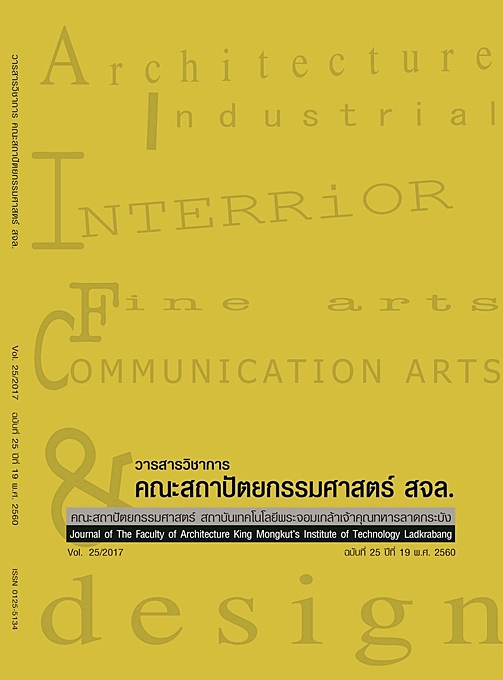เอกลักษณ์ทางกายภาพของตลาดชุมชนริมน้ำบริเวณริมแม่น้ำท่าจีน กรณีศึกษา จังหวัดสุพรรณบุรีและนครปฐม (Physical Identity of Waterfront Community Markets along Tha Chin River: A Case Study of Suphan Buri and Nakhon Pathom Provinces)
Main Article Content
Abstract
บทคัดย่อ
การวิจัยนี้มีวัตถุประสงค์ เพื่อศึกษาสภาพทั่วไปของตลาดชุมชนริมน้ำบริเวณริมแม่น้ำท่าจีนในจังหวัดสุพรรณบุรีและนครปฐม รูปแบบการวางตัวของกลุ่มอาคารและลักษณะสถาปัตยกรรมของอาคารตลาดชุมชนริมบริเวณริมแม่น้ำท่าจีนในจังหวัดสุพรรณบุรีและนครปฐม นำมาสู่บทสรุปเอกลักษณ์ทางกายภายของตลาดชุมชนริมน้ำบริเวณริมแมน้ำท่าจีนในจังหวัดสุพรรณบุรี และนครปฐม โดยใช้วิธีการวิจัยเชิงคุณภาพเพื่ออธิบายลักษณะทางกายภาพของตลาดชุมชนริมน้ำในจังหวัดสุพรรณบุรีและนครปฐม จากการทบทวนวรรณกรรม การลงสำรวจพื้นที่ภาคสนาม ตลอดจนการสัมภาษณ์ในลักษณะของคำถามปลายเปิด ผลการวิจัยพบว่า ตลาดชุมชนริมน้ำบริเวณริมแม่น้ำท่าจีนในจังหวัดสุพรรณบุรีและนครปฐม ทั้งหมด 24 แห่งซึ่งเป็นวิถีของคนในชุมชนตั้งแต่อดีตที่มีการแลกเปลี่ยนผลผลิตทางการเกษตรเพื่อการยังชีพ แต่ละท้องถิ่นมีความแตกต่างกันทั้งประวัติศาสตร์ความเป็นมา ทำเลที่ตั้ง ลักษณะทางเศรษฐกิจ กิจกรรม สังคม วัฒนธรรม ขนบธรรมเนียม และประเพณีอันสะท้อนรูปแบบการวางตัวและลักษณะทางสถาปัตยกรรมของอาคารตลาดชุมชนริมน้ำตามบริบท โดยรูปแบบการวางตัวของกลุ่มอาคารตลาดชุมชนริมน้ำในจังหวัดสุพรรณบุรีมีรูปแบบการตั้งถิ่นฐานแบบกลุ่ม ที่เกาะตัวตามพื้นที่เกษตรกรรม แหล่งน้ำและเส้นทางคมนาคม มีรูปแบบการวางตัวของกลุ่มอาคารตั้งฉากกับแม่น้ำ และมีลักษณะของแผนผังในภาพรวมแบบเกาะตัวตามยาว ที่มีเส้นทางสัญจรเป็นตัวกำหนดลักษณะการวางตัวของเรือนค้าขายที่มีการเรียงตัวกันอย่างต่อเนื่อง ส่วนตลาดชุมชนริมน้ำในจังหวัดนครปฐม มีรูปแบบการตั้งถิ่นฐานแบบกลุ่ม และมีกลุ่มอาคารตั้งฉากกับแม่้ำเช่นเดียวกัน แตกต่างกันที่ลักษณะของแผนผังตลาดชุมชนริมน้ำที่มีทั้งแบบเกาะตัวตามยาวและเกาะกันเป็นกลุ่มปรากฏอยู่ในพื้นที่จำนวนตลาดเท่ากัน ทั้งนี้ลักษณะทางสถาปัตยกรรมของอาคารตลาดชุมชนริมน้ำส่วนใหญ่เป็นอาคารเรือนแถวไม้ ซึ่งลักษณะทางกายภาพที่โดดเด่นดังกล่าวจึงถือเป็นเอกลักษณ์ทางกายภาพของตลาดชุมชนริมน้ำบริเวณริมแม่น้ำท่าจีนในจังหวัดสุพรรณบุรีและนครปฐม
คำสำคัญ: เอกลักษณ์ทางกายภาพ ตลาดชุมชนริมน้ำ แม่น้ำท่าจีน
Abstracts
This research aims to study the physical characteristic of the Waterfront Community Markets along Tha Chin River in Suphan Buri and Nakhon Pathom Provinces. It includes building pattern and architectural characteristic of the markets and leads to a conclusion of the waterfront community market’s physical identity.This research employs a qualitative research to explore the physical characteristic of the markets by using literature reviews, survey and open-end interviews. It is found that the total number of the 24 waterfront community markets is based on a traditional lifestyle since agricultural-based community for living. However, there are some slight differentiations among all the markets in terms of community history, location, economic characteristic, social activity, culture, norm, and custom which reflect in the building pattern and the characteristic of the building. For the markets in Suphan Buri, the community is clustering along agricultural area, water source and community route, and the building locates in the upright position against the river and its markets stretch along the river in which the community route leads the location of the commercial building. For the markets in Nakhon Pathom, it is a cluster community and the building also locates in the upright position against the river. However, its markets equally stretch and surround the river. For both provinces, the building characteristic is rather distinct with wooden row houses which are considered as a traditional style of the Tha Chin River.
Keywords: Physical Identity, Waterfront Community Market, Tha Chin River
Article Details
This work is licensed under a Creative Commons Attribution-NonCommercial-ShareAlike 4.0 International License.
Copyright Transfer Statement
The copyright of this article is transferred to Journal of The Faculty of Architecture King Mongkut's Institute of Technology Ladkrabang with effect if and when the article is accepted for publication. The copyright transfer covers the exclusive right to reproduce and distribute the article, including reprints, translations, photographic reproductions, electronic form (offline, online) or any other reproductions of similar nature.
The author warrants that this contribution is original and that he/she has full power to make this grant. The author signs for and accepts responsibility for releasing this material on behalf of any and all co-authors.


